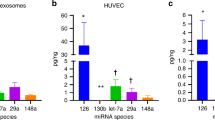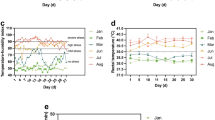Abstract
Non-Hispanic Black (NHB) people have a 2.5-fold higher risk of maternal mortality when compared to non-Hispanic White (NHW) people. Neonates of NHB people are more likely to be born preterm and small for gestational age, which may be driven by structural racism. The placenta is very sensitive to the maternal environment and may play a critical role in the translation of environmental stressors to pregnancy outcomes. Our aim was to assess the placental miRNA expression profile in both NHB and NHW people and the association between differentially expressed miRNAs and pregnancy outcomes. Placentas were collected from 50 NHB and 74 NHW people with a normal singleton pregnancy undergoing elective cesarean section at term prior to the onset of labor. Placental miRNA expression was measured via whole-genome small RNA-sequencing in a subset of 77 placentas. Fifteen miRNAs were more highly expressed in the placentas of NHB people. Several of these miRNAs were associated with cellular stress response pathways, suggesting that they may be responding to environmental stressors. Placental miR-192-5p expression was lower among NHB people and was positively associated with neonatal adiposity, suggesting it may be sensitive to structural racism with potential impacts on fetal growth.


Similar content being viewed by others
References
Hoyert DL. Maternal mortality rates in the United States, 2019. 2020. Retrieved from https://stacks.cdc.gov/view/cdc/103855
Martin JA. Births in the United States, 2018, 2019;(346):8.
Bryant AS, Worjoloh A, Caughey AB, Washington AE. Racial/ethnic disparities in obstetric outcomes and care: prevalence and determinants. Am J Obstet Gynecol. 2010;202(4):335–43. https://doi.org/10.1016/j.ajog.2009.10.864.
Tanaka M, Jaamaa G, Kaiser M, Hills E, Soim A, Zhu M, … McNutt L-A. Racial disparity in hypertensive disorders of pregnancy in New York State: a 10-year longitudinal population-based study. Am J Public Health. 2007;97(1):163–170. https://doi.org/10.2105/AJPH.2005.068577.
Matoba N, Mestan KK, Collins JW. Understanding racial disparities of preterm birth through the placenta. Clin Ther. 2021;43(2):287–96. https://doi.org/10.1016/j.clinthera.2020.12.013.
Pham, O., Nov 10, U. R. P. Racial disparities in maternal and infant health: an overview - issue brief. KFF. 2020. Retrieved from https://www.kff.org/report-section/racial-disparities-in-maternal-and-infant-health-an-overview-issue-brief/
Roy-Matton N, Moutquin J-M, Brown C, Carrier N, Bell L. The impact of perceived maternal stress and other psychosocial risk factors on pregnancy complications. J Obstet Gynaecol Can. 2011;33(4):344–52. https://doi.org/10.1016/S1701-2163(16)34852-6.
Aplin JD, Myers JE, Timms K, Westwood M. Tracking placental development in health and disease. Nat Rev Endocrinol. 2020;16(9):479–94. https://doi.org/10.1038/s41574-020-0372-6.
Matoba N, Yallapragada S, Davis MM, Ernst LM, Collins JW, Mestan KK. Racial differences in placental pathology among very preterm births. Placenta. 2019;83:37–42. https://doi.org/10.1016/j.placenta.2019.06.385.
Assibey-Mensah V, Parks WT, Gernand AD, Catov JM. Race and risk of maternal vascular malperfusion lesions in the placenta. Placenta. 2018;69:102–8. https://doi.org/10.1016/j.placenta.2018.07.017.
Chen Y, Huang L, Zhang H, Klebanoff M, Yang Z, Zhang J. Racial disparity in placental pathology in the collaborative perinatal project. Int J Clin Exp Pathol. 2015;8(11):15042–54.
Jones CW, Gambala C, Esteves KC, Wallace M, Schlesinger R, O’Quinn M, … Drury SS (2017) Differences in placental telomere length suggest a link between racial disparities in birth outcomes and cellular aging. Am J Obstet Gynecol 216(3):294.e1–294.e8. https://doi.org/10.1016/j.ajog.2016.11.1027.
Geronimus AT. Black/white differences in the relationship of maternal age to birthweight: a population-based test of the weathering hypothesis. Soc Sci Med. 1996;42(4):589–97. https://doi.org/10.1016/0277-9536(95)00159-X.
Wan G, Mathur R, Hu X, Zhang X, Lu X. miRNA response to DNA damage. Trends Biochem Sci. 2011;36(9):478–84. https://doi.org/10.1016/j.tibs.2011.06.002.
Mouillet J-F, Ouyang Y, Coyne CB, Sadovsky Y. MicroRNAs in placental health and disease. Am J Obstet Gynecol. 2015;213(4):S163–72. https://doi.org/10.1016/j.ajog.2015.05.057.
O’tierney-Ginn PF, Alvarado F. Placental miR-3940-3p is associated with maternal insulin resistance in late pregnancy. Harvard Dataverse. 2021. https://doi.org/10.7910/DVN/SSSL2D.
Miguel V, Cui JY, Daimiel L, Espinosa-Díez C, Fernández-Hernando C, Kavanagh TJ, Lamas S. The role of microRNAs in Environmental risk factors, noise-induced hearing loss, and mental stress. Antioxid Redox Signal. 2018;28(9):773–96. https://doi.org/10.1089/ars.2017.7175.
Costello JF, Fisher SJ. The placenta - fast, loose, and in control. N Engl J Med. 2021;385(1):87–9. https://doi.org/10.1056/NEJMcibr2106321.
Catalano PM, Thomas AJ, Avallone DA, Amini SB. Anthropometric estimation of neonatal body composition. Am J Obstet Gynecol. 1995;173(4):1176–81. https://doi.org/10.1016/0002-9378(95)91348-3.
Langmead B, Trapnell C, Pop M, Salzberg SL. Ultrafast and memory-efficient alignment of short DNA sequences to the human genome. Genome Biol. 2009;10(3):R25. https://doi.org/10.1186/gb-2009-10-3-r25.
Anders S, Huber W. Differential expression analysis for sequence count data. Genome Biol. 2010;11(10):R106. https://doi.org/10.1186/gb-2010-11-10-r106.
Benjamini Y, Hochberg Y. Controlling the false discovery rate: a practical and powerful approach to multiple testing. J R Stat Soc Ser B (Methodol). 1995;57(1):289–300. https://doi.org/10.1111/j.2517-6161.1995.tb02031.x.
Livak KJ, Schmittgen TD. Analysis of relative gene expression data using real-time quantitative PCR and the 2−ΔΔCT method. Methods. 2001;25(4):402–8. https://doi.org/10.1006/meth.2001.1262.
RStudio Team. RStudio: integrated development for R. Boston, MA: RStudio, PBC; 2020. Retrieved from http://www.rstudio.com/.
Chang L, Zhou G, Soufan O, Xia J. miRNet 2.0: network-based visual analytics for miRNA functional analysis and systems biology. Nucl Acids Res. 2020;48(W1):W244–51. https://doi.org/10.1093/nar/gkaa467.
Huang H-Y, Lin Y-C-D, Li J, Huang K-Y, Shrestha S, Hong H-C, … Huang H-D. miRTarBase 2020: updates to the experimentally validated microRNA-target interaction database. Nucl Acids Res 2020;48(D1):D148–D154. https://doi.org/10.1093/nar/gkz896.
Karagkouni D, Paraskevopoulou MD, Chatzopoulos S, Vlachos IS, Tastsoglou S, Kanellos I, Hatzigeorgiou AG. DIANA-TarBase v8: a decade-long collection of experimentally supported miRNA–gene interactions. Nucl Acids Res. 2018;46(Database issue):D239–45. https://doi.org/10.1093/nar/gkx1141.
Fabregat A, Sidiropoulos K, Viteri G, Marin-Garcia P, Ping P, Stein L, … Hermjakob H. Reactome diagram viewer: data structures and strategies to boost performance. Bioinformatics (Oxford, England). 2018;34(7):1208–1214. https://doi.org/10.1093/bioinformatics/btx752.
Li Q, Kappil MA, Li A, Dassanayake PS, Darrah TH, Friedman AE, … Chen J. Exploring the associations between microRNA expression profiles and environmental pollutants in human placenta from the National Children’s Study (NCS). Epigenetics. 2015;10(9):793–802. https://doi.org/10.1080/15592294.2015.1066960.
Hollins SL, Cairns MJ. MicroRNA: Small RNA mediators of the brains genomic response to environmental stress. Prog Neurobiol. 2016;143:61–81. https://doi.org/10.1016/j.pneurobio.2016.06.005.
Li L, Stary CM. Targeting glial mitochondrial function for protection from cerebral ischemia: relevance, mechanisms, and the role of microRNAs. Oxid Med Cell Longev. 2016;2016:6032306. https://doi.org/10.1155/2016/6032306.
Wang X-F, Shi Z-M, Wang X-R, Cao L, Wang Y-Y, Zhang J-X, … You Y-P. MiR-181d acts as a tumor suppressor in glioma by targeting K-ras and Bcl-2. J Cancer Res Clin Oncol. 2012;138(4):573–584. https://doi.org/10.1007/s00432-011-1114-x.
Brunst KJ, Zhang L, Zhang X, Baccarelli AA, Bloomquist T, Wright RJ. Associations between maternal lifetime stress and placental mitochondrial DNA mutations in an urban multiethnic cohort. Biol Psychiat. 2021;89(6):570–8. https://doi.org/10.1016/j.biopsych.2020.09.013.
Ren F, Yao Y, Cai X, Fang G. Emerging role of MiR-192-5p in human diseases. Front Pharmacol. 2021;12:614068. https://doi.org/10.3389/fphar.2021.614068.
Lampl M, Lee W, Koo W, Frongillo EA, Barker DJP, Romero R. Ethnic differences in the accumulation of fat and lean mass in late gestation. Am J Hum Biol. 2012;24(5):640–7. https://doi.org/10.1002/ajhb.22285.
Westerheide SD, Morimoto RI. Heat shock response modulators as therapeutic tools for diseases of protein conformation*. J Biol Chem. 2005;280(39):33097–100. https://doi.org/10.1074/jbc.R500010200.
Lewis S, Handy RD, Cordi B, Billinghurst Z, Depledge MH. Stress proteins (HSP’s): methods of detection and their use as an environmental biomarker. Ecotoxicology. 1999;8(5):351–68. https://doi.org/10.1023/A:1008982421299.
Stress proteins: the biological functions in virus infection, present and challenges for target-based antiviral drug development | Signal Transduction and Targeted Therapy. (n.d.). Retrieved November 16, 2021, from https://www-nature-com.ezproxy.library.tufts.edu/articles/s41392-020-00233-4.
Geronimus AT, Hicken M, Keene D, Bound J. “Weathering” and age patterns of allostatic load scores among Blacks and Whites in the United States. Am J Public Health. 2006;96(5):826–33. https://doi.org/10.2105/AJPH.2004.060749.
Forde AT, Crookes DM, Suglia SF, Demmer RT. The weathering hypothesis as an explanation for racial disparities in health: a systematic review. Ann Epidemiol. 2019;33:1-18.e3. https://doi.org/10.1016/j.annepidem.2019.02.011.
Acknowledgements
We would like to thank Dr. Mary Haghiac and Ms. Judi Minium for contributing to the recruitment and sample and data collection.
Funding
This research was supported by the National Institute of Health grant R01HD091735.
Author information
Authors and Affiliations
Contributions
All authors have reviewed and approved the final manuscript, contributed to the interpretation of the data. P.O–G, F.L.A., and T.C. conceived of the design of the study and contributed to the data analysis. F.L.A., A.S., and T.C. performed the experiments. F.L.A. and P.O–G. drafted the manuscript, and Y.S., N.A-O., and T.C. critically reviewed the data and the manuscript.
Corresponding author
Ethics declarations
Ethics Approval
All procedures performed in studies involving human participants were in accordance with the ethical standards of the institutional and/or national research committee and with the 1964 Helsinki Declaration and its later amendments or comparable ethical standards. This study was approved by the Institutional Review Board of Tufts Medical Center (IRB #12842) and Metro Health Medical Center (IRB #1300650).
Consent to Participate
Informed consent was obtained from all individual participants included in the study.
Competing Interests
The authors declare no competing interests.
Supplementary Information
Below is the link to the electronic supplementary material.
Rights and permissions
About this article
Cite this article
Alvarado-Flores, F., Savelyeva, A., Chu, T. et al. Placental miRNAs Targeting Cellular Stress Response Pathways Are Highly Expressed in Non-Hispanic Black People. Reprod. Sci. 29, 2043–2050 (2022). https://doi.org/10.1007/s43032-022-00895-1
Received:
Accepted:
Published:
Issue Date:
DOI: https://doi.org/10.1007/s43032-022-00895-1




